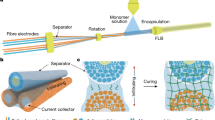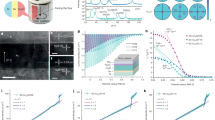Abstract
We demonstrate the translation of a low-cost, non-precious metal cobalt phosphide (CoP) catalyst from 1 cm2 lab-scale experiments to a commercial-scale 86 cm2 polymer electrolyte membrane (PEM) electrolyser. A two-step bulk synthesis was adopted to produce CoP on a high-surface-area carbon support that was readily integrated into an industrial PEM electrolyser fabrication process. The performance of the CoP was compared head to head with a platinum-based PEM under the same operating conditions (400 psi, 50 °C). CoP was found to be active and stable, operating at 1.86 A cm−2 for >1,700 h of continuous hydrogen production while providing substantial material cost savings relative to platinum. This work illustrates a potential pathway for non-precious hydrogen evolution catalysts developed in past decades to translate to commercial applications.
This is a preview of subscription content, access via your institution
Access options
Access Nature and 54 other Nature Portfolio journals
Get Nature+, our best-value online-access subscription
$29.99 / 30 days
cancel any time
Subscribe to this journal
Receive 12 print issues and online access
$259.00 per year
only $21.58 per issue
Buy this article
- Purchase on Springer Link
- Instant access to full article PDF
Prices may be subject to local taxes which are calculated during checkout


Similar content being viewed by others
Data availability
The X-ray diffraction reference pattern is available from the Materials Project database under the ID mp-22270. Source data for figures is provided along with the paper as a supplemental file. Additional data that supports the plots within this paper and other findings of this study are available from the corresponding author upon reasonable request.
References
Bertuccioli, L. et al. Development of Water Electrolysis in the European Union (Fuel cells and hydrogen joint undertaking, 2014).
Vesborg, P. C. K. & Jaramillo, T. F. RSC Adv. 2, 7933–7947 (2012).
Hinnemann, B. et al. J. Am. Chem. Soc. 36, 5308–5309 (2005).
Jaramillo, T. F. et al. Science 317, 100–102 (2007).
Callejas, J. F., Read, C. G., Roske, C. W., Lewis, N. S. & Schaak, R. E. Chem. Mater. 28, 6017–6044 (2016).
Shi, Y. & Zhang, B. Chem. Soc. Rev. 45, 1529–1541 (2016).
Kibsgaard, J. & Jaramillo, T. F. Angew. Chem. Int. Ed. 53, 14433–14437 (2014).
Mccrory, C. C. L. et al. J. Am. Chem. Soc. 137, 4347–4357 (2015).
Corrales-Sánchez, T., Ampurdanés, J. & Urakawa, A. Int. J. Hydrog. Energy 39, 20837–20843 (2014).
Ng, J. W. D. et al. ChemSusChem. 8, 3512–3519 (2015).
Di Giovanni, C. et al. ACS Catal. 6, 2626–2631 (2016).
Sun, X. et al. Catalysts 8, 657 (2018).
Anantharaj, S. et al. ACS Catal. 6, 8069–8097 (2016).
Xiao, P., Chen, W. & Wang, X. Adv. Energy Mater. 5, 1–13 (2015).
Liu, W. et al. Nat. Commun. 7, 1–9 (2016).
Popczun, E. J., Read, C. G., Roske, C. W., Lewis, N. S. & Schaak, R. E. Angew. Chem. Int. Ed. 53, 5427–5430 (2014).
Kibsgaard, J. et al. Energy Environ. Sci. 8, 3022–3029 (2015).
Hellstern, T. R., Benck, J. D., Kibsgaard, J., Hahn, C. & Jaramillo, T. F. Adv. Energy Mater. 6, 1501758 (2016).
Wu, Z., Huang, L., Liu, H. & Wang, H. ACS Catal. 9, 2956–2961 (2019).
Saadi, F. H. et al. J. Am. Chem. Soc. 139, 12927–12930 (2017).
Yang, H., Zhang, Y., Hu, F. & Wang, Q. Nano Lett. 15, 7616–7620 (2015).
Zhou, D. et al. J. Mater. Chem. A 4, 10114–10117 (2016).
Martens, S. et al. J. Power Sources 392, 274–284 (2018).
Alia, S. M. et al. J. Electrochem. Soc. 163, F3105–F3112 (2016).
Alia, S. M. & Pivovar, B. S. ACS Catal. 8, 2111–2120 (2018).
Weiß, A. et al. J. Electrochem. Soc. 166, 487–497 (2019).
Zhang, Y., Gao, L., Hensen, E. J. M. & Hofmann, J. P. ACS Energy Lett. 3, 1360–1365 (2018).
Ledendecker, M. et al. Angew. Chem. 129, 9899–9903 (2017).
James, B., Colella, W., Moton, J., Saur, G. & Ramsden, T. PEM Electrolysis H2A Production Case Study Documentation (US Department of Energy Fuel Cell Technologies Office, 2013).
Babic, U., Suermann, M., Büchi, F. N., Gubler, L. & Schmidt, T. J. J. Electrochem. Soc. 164, F387–F399 (2017).
H2@Scale Workshop Report (National Renewale Energy Laboratory, 2017).
Acknowledgements
We acknowledge the Department of Defence Small Business Innovation Research Phase I (contract no. N00024-17-P-4507; topic no. N162-107) for financial support and the project manager J. Manney. Fundamental catalyst development efforts were supported by the US Department of Energy, Office of Science, Office of Basic Energy Sciences, Chemical Sciences, Geosciences and Biosciences Division, Catalysis Science Programme through the SUNCAT Centre for Interface Science and Catalysis. Physical characterization of the catalyst in this work was performed at the Stanford Nano Shared Facilities, supported by the National Science Foundation (award no. ECCS-1542152). We thank R. Chin for his assistance with SEM at this facility. M.A.H. acknowledges the support of a National Science Foundation Graduate Research Fellowship.
Author information
Authors and Affiliations
Contributions
L.A.K. and M.A.H. contributed equally to this work and are the primary authors of the manuscript. L.A.K., M.A.H. and T.R.H. synthesized CoP catalysts. L.A.K. performed XRD and SEM characterization. E.V. performed TEM characterization. M.A.H. performed electrochemical lab-scale characterization and testing. C.C., J.M. and N.D. prepared all PEM stack components, assembled and tested the electrolyser and collected all operational data. T.F.J. and K.A. supervised the work. All authors contributed to data analysis and discussions, including manuscript preparation and editing.
Corresponding author
Ethics declarations
Competing interests
The authors declare no competing interests.
Additional information
Peer review information Nature Nanotechnology thanks Foteini Sapountzi and the other, anonymous, reviewer(s) for their contribution to the peer review of this work.
Publisher’s note Springer Nature remains neutral with regard to jurisdictional claims in published maps and institutional affiliations.
Supplementary information
Supplementary information
Supplementary Figs. 1–9, Tables 1–4 and refs. 1–8.
Rights and permissions
About this article
Cite this article
King, L.A., Hubert, M.A., Capuano, C. et al. A non-precious metal hydrogen catalyst in a commercial polymer electrolyte membrane electrolyser. Nat. Nanotechnol. 14, 1071–1074 (2019). https://doi.org/10.1038/s41565-019-0550-7
Received:
Accepted:
Published:
Issue Date:
DOI: https://doi.org/10.1038/s41565-019-0550-7
This article is cited by
-
Allotrope-dependent activity-stability relationships of molybdenum sulfide hydrogen evolution electrocatalysts
Nature Communications (2024)
-
Heterophase junction engineering-induced Co spin-state modulation of CoSe2 for large-current hydrogen evolution reaction
Rare Metals (2024)
-
Edge dislocation-induced strains break the limit of PtNi alloys in boosting Pt mass activity for efficient alkaline hydrogen evolution
Nano Research (2024)
-
Ruthenium-lead oxide for acidic oxygen evolution reaction in proton exchange membrane water electrolysis
Nano Research (2024)
-
Sequential reactant water management by complementary multisite catalysts for surpassing platinum hydrogen evolution activity
Nano Research (2024)



